Creation Museum (part 4)
The Red Queen shook her head, “You may call it ‘nonsense’ if you like,” she said, “but I’ve heard nonsense, compared with which that would be as sensible as a dictionary!”
—from Alice’s Adventures in Wonderland by Lewis Carroll

This is Part Four of my series on the Creation Museum and, sadly, the final part. If you’re joining us late, you’ll want to read the other parts first, starting with Part One.
In Part Three we learned about the Great Flood and Noah’s Ark. In the world-view of the Museum, the Flood explains just about everything, from fossils to the Grand Canyon.
Dinosaurs are also central to the Museum experience, presumably because kids love dinosaurs. There were, as it turns out, dinosaurs on the Ark, so while most of them died in the Flood (as did most of the human race) they didn’t become extinct at that time.
Once you’re able to accept the notion of dinosaurs coexisting with humans, humans living more than nine hundred years, and Noah fitting all the animals and food and water for them on a boat for months, you’re about ready to accept anything.
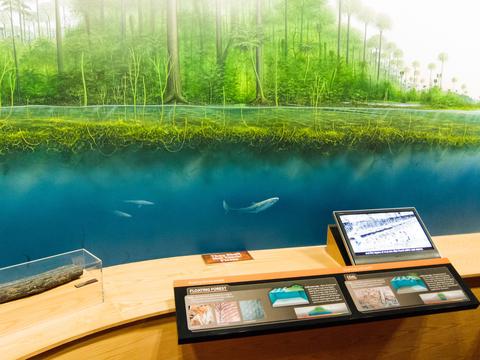
By way of example, we have the Floating Forest. Apparently, the fossil records provide evidence that, before the Great Flood, there was a giant forest floating on the sea.
These are the same fossil records that totally don’t show that dinosaurs lived millions of years ago at a whole different time from humans. But a giant floating forest? Dude, it’s right there, in the fossils. Totally.

The forest was destroyed by the Great Flood: it was unable to withstand the tsunamis and the ravages of all that water flooding the Earth.
Waterlogged tree bark from the forest then sank, and became coal. Apparently a flood of this magnitude has enough power to create fossil fuels very quickly, and the existence of such fuels is thus explained by the flood—and the giant floating forest.
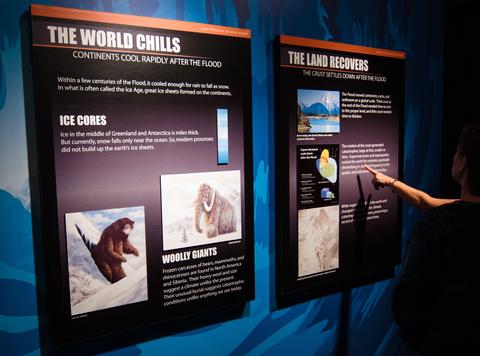
After the Flood receded, the world changed rapidly. Within a few centuries, it had chilled enough for the Ice Age to happen. Just one Ice Age.
Having happened a few centuries after the Flood, this was supposedly about four thousand years ago. If there had been an ice age four thousand years ago, wouldn’t there be some record of that? Did everyone just neglect to mention it? Including the Bible? This is within recorded history, folks.
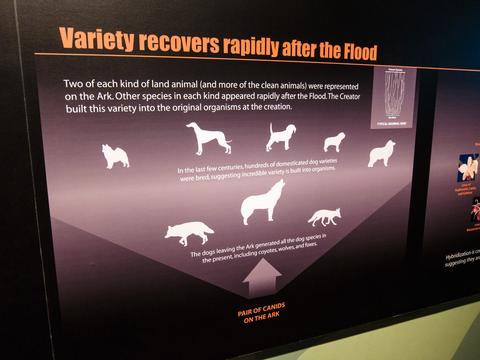
Recall from our previous installments the museum’s pseudo-scientific notion of animal “kinds,” used to explain how all those animals could have fit on the Ark. Pre-programmed into the DNA of dogs, for example, are all the different varieties of dogs we now know: coyotes and wolves, poodles and greyhounds. Thus, Noah needed only two members of the dog “kind” to re-populate the entire dog world. (If dogs were “clean” animals, he’d have had seven.)
After the Flood, the dog DNA somehow knew it needed to re-create all those varieties, and so they all appeared quickly.
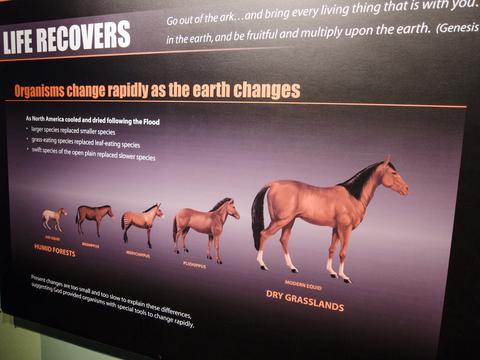
As with dogs, Noah didn’t need every kind of horse or zebra: just representatives of the equid “kind.” This display shows the ancestor of the modern horse as something they’re calling the “ark equid,” conveniently much smaller so as to better fit on the boat.
It should be noted that this “ark equid” is total rubbish, not supported by science.
Since observable natural selection doesn’t work that quickly, we’re told that “God provided organisms with special tools to change rapidly.” When spreading nonsense, “God did it by fiat” is a convenient escape hatch.
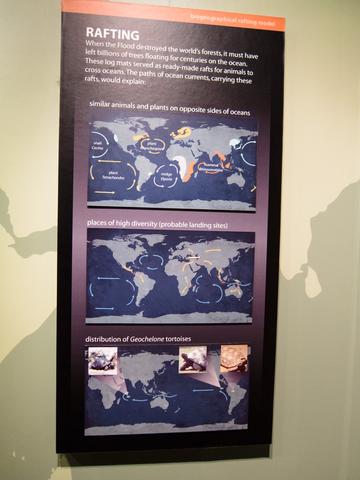
How did different animals end up on all the various modern continents? Rafting, of course!
The Flood, having ripped up most of the world’s trees, would have left a lot of them floating on the sea for centuries. These trees created floating “rafts” that carried animals between the continents—explaining how some similar animals occur on different continents, but others are more unique.
It doesn’t explain how it is that all of this—including the above evolution from “ark equid” to modern horse—happened within recorded history, starting some 4,350 years ago. Egyptians and Sumerians already had societies and were writing things down. But they skipped over all of this? Didn’t think it was important to mention that their entire civilization was wiped out in a giant flood? Or at least the rafting animals?

Televisions playing video loops are always nearby to provide much-needed indoctrination.
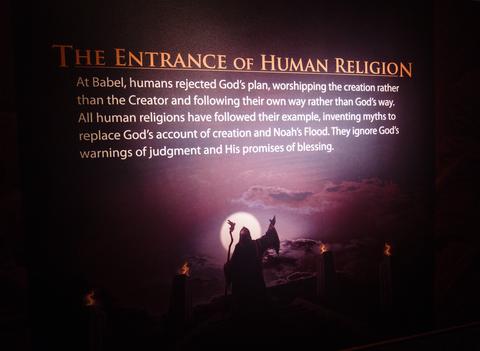
See, all those human religions have invented myths, but not this religion. No myths here, no sir.
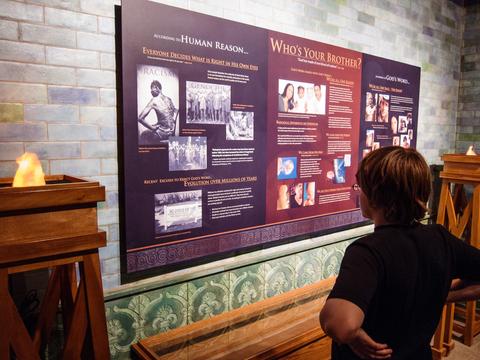
Human reason is to blame for all kinds of bad things, but racism in particular. See, unlike the animals, humans aren’t part of a “kind.” We don’t evolve or change like the animals do: we have always been exactly as we are now, all the same, created in God’s image.
Our superficial differences didn’t exist before the Flood. After the Flood, Noah and his family started a new civilization at Babel—nevermind that, when this was supposedly going on, we know there were already civilizations in Egypt and Mesopotamia and China, keeping records: this was the only human civilization that existed forty-three hundred years ago, recorded history be damned.
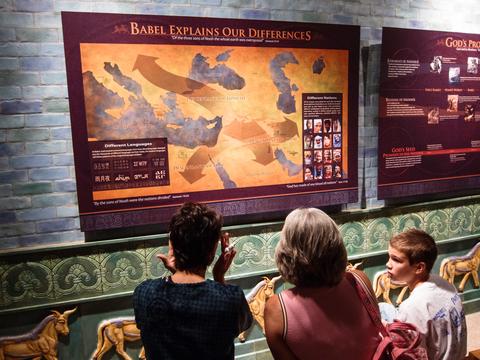
At Babel everyone was the same, in terms of what we now call “race” (a concept that basically didn’t exist in that era). After God created all the different languages, the clans started by each of Noah’s sons spread across the world in different directions, becoming the major racial groups we now know.
This is why we now have difference in appearance among humans: they all went to live separately and adapted to their new environments. The differences, though, are superficial and meaningless.
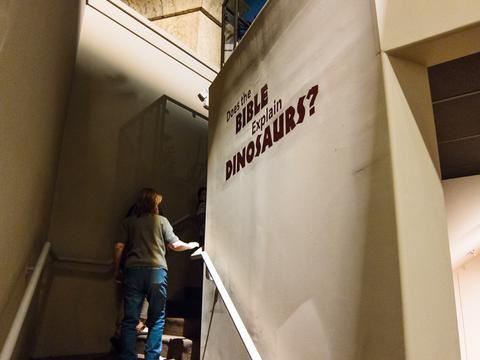
And, back to the dinosaurs. We mustn’t stay too long away from the dinosaurs, lest the children become bored.
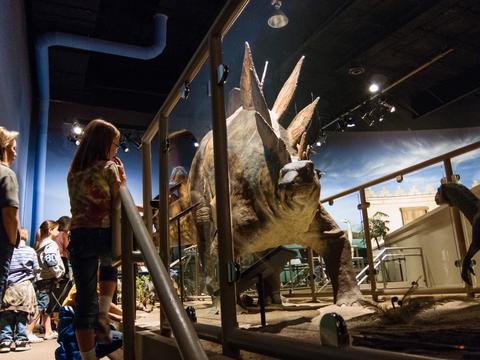
Here we have a large exhibit of dinosaurs, similar to one you might find in a real natural history museum.
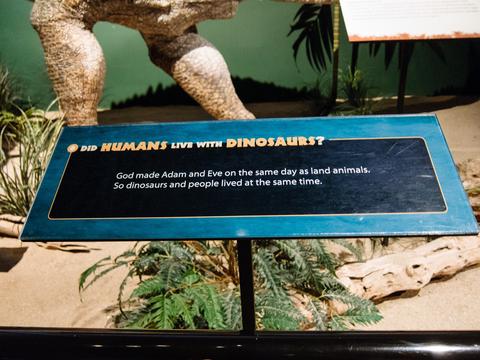
Humans lived at the same time as dinosaurs; the evidence for this is the fact that God created Adam and Eve on the same day as He created the land animals.
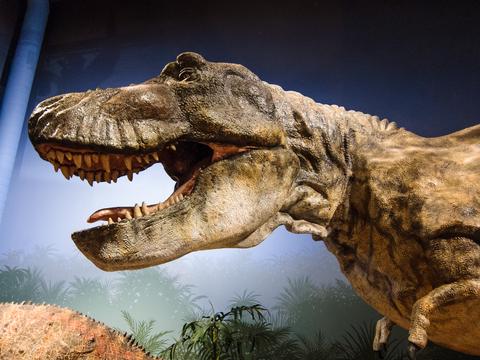
The dinosaurs themselves aren’t bad. Time and money were spent on these exhibits.
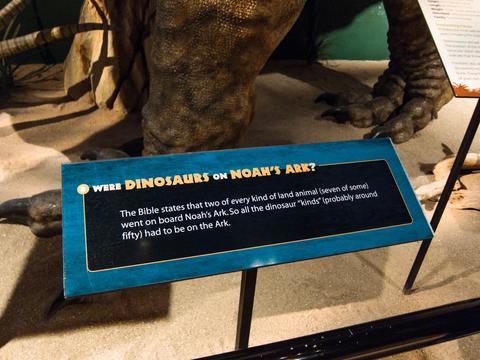
After reducing dinosaurs into “kinds,” we conveniently end up with “about fifty” kinds of dinosaurs that had to be on the Ark.

Water and food for these animals had to be stored on the Ark as well. Recall that, at the time of the Flood, dinosaurs and some other animals (though not humans) had already given up vegetarianism and were eating meat. Did these animals return to vegetarianism for the voyage? Were “extra” animals brought aboard to feed T-Rex and the others?
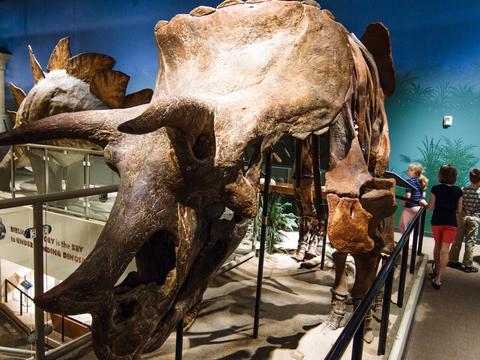
Skeletons are on display as well. It wasn’t clear to me whether these are real, but given that they are within arm’s reach of visitors, I doubt it (and kind of hope not).

“Biblical history is the key to understanding dinosaurs.” Really?

Dinosaurs lived on Earth after the Flood. We know this because they were on the Ark. We know they were on the Ark because they had to be on the Ark, because God said “all” the animals.
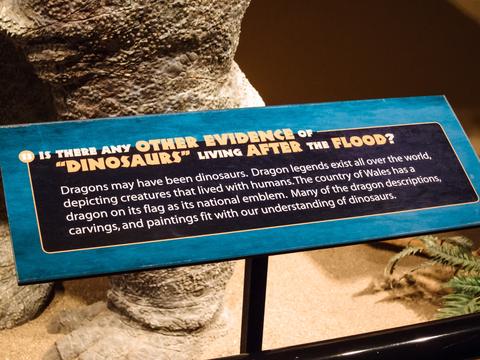
In fact, dinosaurs lived on until at least the middle ages, at which time they were known as “dragons.”

We end with the most frightening revelation of all: there are annual passes to this place, to better enable you to indoctrinate your children!
Come on out every weekend, folks, and make sure your kids don’t fall for any of that pesky “science” stuff they’re constantly bombarded with! We’re here to help!
I’m glad I went to the Creation Museum. It was an interesting and fascinating afternoon.
A number of people have asked me why I would go to such a place, or how I could stand to go through the whole thing. I don’t really understand that perspective: ignoring these people won’t make them go away, and deliberately avoiding things you don’t agree with might make you a good Fox News viewer, but it’s not helpful. It’s easy to dismiss this stuff as the bizarre ravings of a few morons who aren’t important anyway—but Sarah Palin is one of these morons, and she nearly came within one heart attack of being President of the United States.
This Museum shouldn’t exist. People should be smarter than this. But it does exist, because people aren’t smarter than this, and ignoring the problem won’t make it go away.